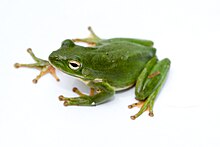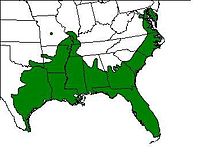American green tree frog
| American green tree frog | |
|---|---|
 |
|
| Scientific classification | |
| Kingdom: | Animalia |
| Phylum: | Chordata |
| Class: | Amphibia |
| Order: | Anura |
| Family: | Hylidae |
| Genus: | Hyla |
| Species: | H. cinerea |
| Binomial name | |
|
Hyla cinerea (Schneider, 1799) |
|
 |
|
| Approximate range | |
| Synonyms | |
|
Calamita cinerea Schneider, 1799 |
|
Calamita cinerea Schneider, 1799
Hyla viridis Holbrook, 1842
Hyla cinerea Garman, 1892
Hyla carolinensis Cope, 1889
The American green tree frog (Hyla cinerea) is a common species of New World tree frog belonging to the genus Hyla. A common backyard species, it is popular as a pet, and is the state amphibian of Georgia and Louisiana.
The frog is green, medium-sized, and up to 6 cm (2.5 in) long. Their bodies are usually green in shades ranging from bright yellowish-olive to lime green. The color can change depending on lighting or temperature. Small patches of gold or white may occur on the skin, and they may also have a white, pale yellow, or cream-colored lines running from their jaws or upper lips to their groins. They have smooth skin and large toe pads. Their abdomens are pale yellow to white. Males have wrinkled throats (indicating the vocal pouch) and are slightly smaller than females.
These frogs are found in the central and southeastern United States, with a geographic range from the Eastern Shore of Virginia to southeast Florida, with populations as far west as central Texas, and as far north as Maryland and Delaware. The frogs are considered monotypic, but clinal variation has been observed from Florida north along the Atlantic coastal plain. This possibly may be attributed "to the result of strong selection and/or drift."
...
Wikipedia

